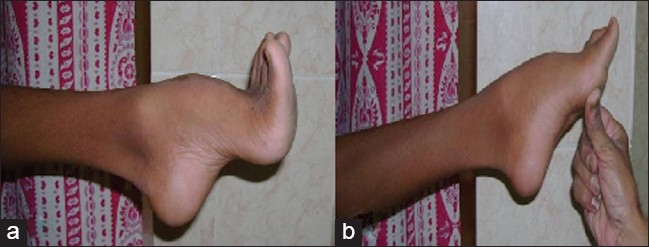File:Pes Cavus Deformity.jpg
Pes_Cavus_Deformity.jpg (649 × 247 pixels, file size: 79 KB, MIME type: image/jpeg)
High arch (Pes cavus)
Pes Cavus is a foot deformity affecting Friedrich's ataxia patients.
Clinical photographs showing pes cavus deformity (a) which gets partially corrected (b) on manually lifting 1st metatarsal (MT) head.
- Links: PubMed Health
Reference
Chatterjee P & Sahu MK. (2009). A prospective study of Japas' osteotomy in paralytic pes cavus deformity in adolescent feet. Indian J Orthop , 43, 281-5. PMID: 19838351 DOI.
Copyright
This is an open-access article distributed under the terms of the Creative Commons Attribution License, which permits unrestricted use, distribution, and reproduction in any medium, provided the original work is properly cited.
Assessment
+ Relevant clinical image to group project. + Includes reference, copyright and student disclaimer. + Legend includes some description for peer teaching. Could have provided more information about how this deformity is generated.
- Note - This image was originally uploaded as part of a student project and may contain inaccuracies in either description or acknowledgements. Students have been advised in writing concerning the reuse of content and may accidentally have misunderstood the original terms of use. If image reuse on this non-commercial educational site infringes your existing copyright, please contact the site editor for immediate removal.
Cite this page: Hill, M.A. (2024, April 26) Embryology Pes Cavus Deformity.jpg. Retrieved from https://embryology.med.unsw.edu.au/embryology/index.php/File:Pes_Cavus_Deformity.jpg
- © Dr Mark Hill 2024, UNSW Embryology ISBN: 978 0 7334 2609 4 - UNSW CRICOS Provider Code No. 00098G
File history
Click on a date/time to view the file as it appeared at that time.
| Date/Time | Thumbnail | Dimensions | User | Comment | |
|---|---|---|---|---|---|
| current | 16:32, 9 September 2011 | 649 × 247 (79 KB) | Z3294943 (talk | contribs) | Pes Cavus, a foot deformity affecting FRDA patients. Figure 1 Clinical photographs showing pes cavus deformity (a) which gets partially corrected (b) on manually lifting 1st MT head Copyright: This is an open-access article distributed under the terms |
You cannot overwrite this file.
File usage
The following 2 pages use this file:
